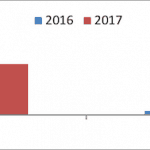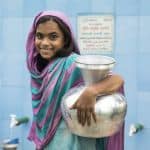How Your Business Can Help End the Global Water and Sanitation Crisis: Highlights from a New Report
No one need explain the true value of water to 54-year-old Elizabeth and her family in Port Moresby, Papua New Guinea. She spends more than half her meagre salary on buying drinking water from a local water vendor, as she knows the water from the nearby lake could make her unwell, unproductive and unable to provide for her family.
Elizabeth knows that installing a safe water supply and decent toilet close to her home and market stall makes good business sense. She’ll spend less money on buying water. And a decent toilet will increase her productivity and reduce her absence from work, because she’ll get sick less often. In the long run, if $1 were invested in water and sanitation, an average of $4 would be returned in increased productivity.
Imagine now that instead of Elizabeth working at an independent market stall, she works in the supply chain of a multinational food retailer. The lack of access to water, sanitation and hygiene (WASH) in her workplace could cost the company millions in lost productivity; every year, the equivalent of $4 billion in working days are lost due to poor sanitation.
Globally, 1.5 billion people work in supply chains. Of those, up to 1.35 billion are employed in small and medium-sized enterprises, or on farms in developing countries, where the water and sanitation crisis is most acute. That’s why businesses, as a key component of good water stewardship practice, can and must take action to help achieve Sustainable Development Goal 6 of reaching everyone, everywhere with taps and toilets by 2030.
While more multinationals are wising up to the benefits of providing water and sanitation to their workforce, a new report jointly commissioned by WaterAid, the World Business Council for Sustainable Development (WBCSD) and the UN Global Compact’s CEO Water Mandate found there are a number of opportunities that could still be seized upon to drive substantial progress. These opportunities could be driven by collaborative efforts between companies and the WASH community.
Defining ‘acceptable’ good practice
The research – conducted by Water Witness International with support from the HSBC Water Program – found that even multinational companies considered to be progressive on water, sanitation and hygiene provision admitted they need better guidance about what is considered “acceptable” good practice, particularly in areas that go beyond just ensuring the availability of water or toilets in the workplace. Issues requiring attention include what should be the proximity of workplace latrines to the workers’ base, which is particularly important for farmers, and the requirements for women who are menstruating.
The research also identified the need for businesses to develop a more holistic approach, as well as to have more WASH-specific elements within their codes of conduct for suppliers. A code of conduct which simply states that “workers must have access to water and sanitation facilities” needs more specifics and guidance to be effective.
Organizations such as Fair Trade and the Better Cotton Initiative could also be encouraged to incorporate WASH elements into their criteria, standards or certification frameworks.
Tightening up the definition of acceptable water, sanitation and hygiene services, strengthening existing standards, and implementing more holistic codes of conduct can drive change at all levels, from the boardroom down to the factory floor or field.
The report sets out an “ideal” approach to water, sanitation and hygiene, which businesses could consider when implementing these services in their supply chains. Going forward, corporations and those working in the sector need to develop, test and publish good practices on how to handle WASH in supply chains, and encourage others to follow suit.
Access to reliable data
The research also found there is a clear need for companies to have reliable data on the benefits of providing access to clean water, sanitation and hygiene to employees. Getting such data allows corporations to make the internal case for access to water, toilets and hygiene in the workplace.
The World Health Organization estimates the financial benefits of providing everyone across sub-Saharan Africa with water and sanitation would amount to US $23.5 billion a year. However, there is a lack of strong evidence to demonstrate other benefits, including reduced absenteeism, higher productivity, as well as staff and supplier loyalty.
NGOs such as WaterAid and cross-sector bodies like CEO Water Mandate and WBCSD are key partners in demonstrating how investing in taps and toilets can contribute to core business values, both ethically and financially.
Next steps
So what steps can your company take to help end the water and sanitation crisis?
- Sign and implement the WBCSD WASH at the workplace Pledge ensuring that all employees in direct operations have access to safe WASH while at work. (For more, click here.)
- Broaden and deepen your employee and company understanding about WASH by providing them with the International Labour Organization’s WASH@Work self-training handbook.
- Update your supplier codes; a draft set of criteria for optimal water, sanitation and hygiene provision in supply chains is available for pilot testing by companies.
- Contribute to strengthening the business case for WASH by offering opportunities for evidence-gathering from your operations and projects.
- Learn about and engage in the WASH4Work initiative, working with a group of agencies, companies and development partners to address the WASH challenge.
If you want to learn more about WASH in supply chains and the findings from the latest report, join the debate at Stockholm World Water Week on Aug. 27. The session will be chaired by WaterAid, Water Witness International, the CEO Water Mandate and WBCSD. For more information, click here.
Sara Traubel is a manager in the World Business Council for Sustainable Development (WBCSD) water program; Mai-Lan Ha serves as senior adviser to the CEO Water Mandate and senior research associate at the Pacific Institute; and Ruth Romer is the expert focal point on private sector engagement for WaterAid.
Photo courtesy of Nestlé
- Categories
- Environment, Health Care, WASH



